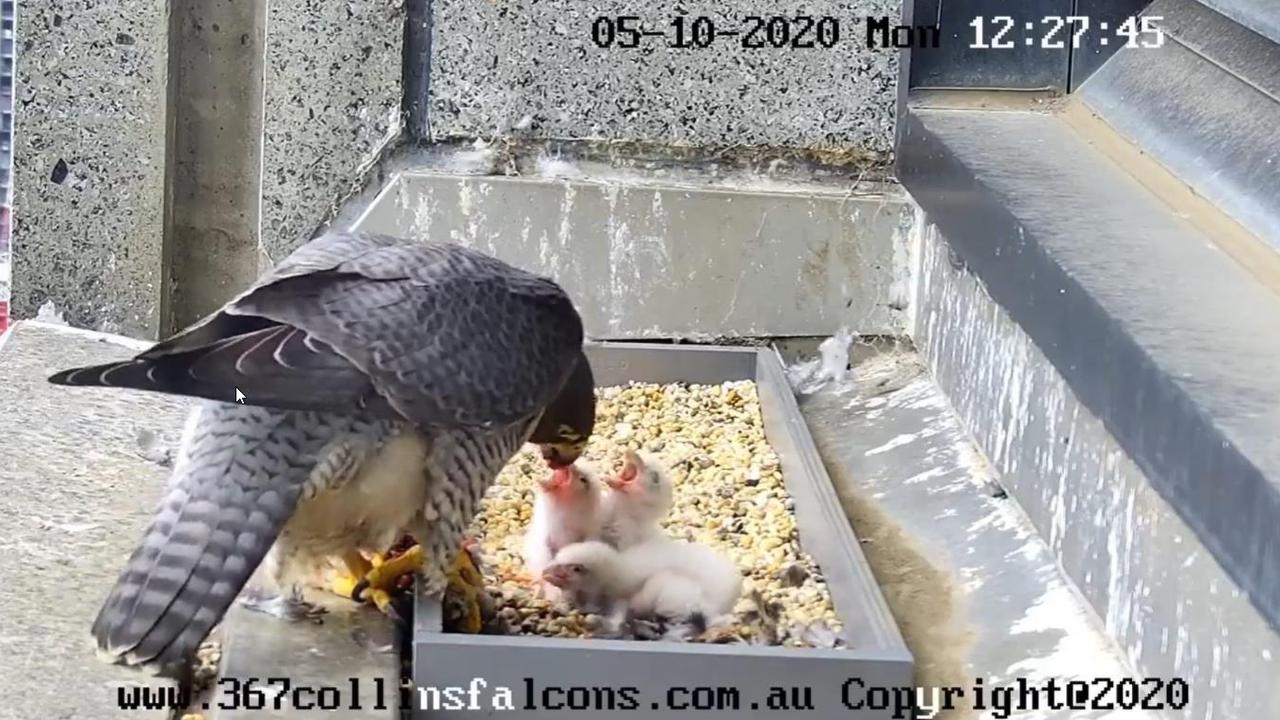All the action of the famous peregrine falcon family
Three peregrine falcon chicks have hatched in a nest on the side of a Melbourne skyscraper. The birds are the stars of a live webcam watched by thousands of people around the world

READING LEVEL: GREEN
Three peregrine falcon chicks have hatched in a nest on the side of a Melbourne skyscraper.
The chicks and their parents are the stars of a live webcam watched by thousands of people around the world over the past month.
(You can read our previous story HERE.)
Regular watchers reported the first chick hatched on Friday morning, with the remaining two chicks hatching throughout Friday.
The family of falcons is in a human-made, pebble-filled nesting box on the side the building at 367 Collins Street. Peregrine falcons do not make their own nests, but find a suitable nook* in a safe place such as a ledge on a cliff, away from predators.
Just before 10am on Monday, Kids News reporters watched one of the falcon parents (believed to be the father) fly away, leaving the fluffy white chicks alone, before returning minutes later with a meal of what appeared to be a young, unfeathered bird of another species.
The adult falcon then fed its chicks pieces of the meal from its beak.
One chick appeared to get most of the meal, one chick got some and a third chick (rarely putting its head as high as the others or in a direction facing its parent) received very little food compared to its siblings.
Later on Monday, the two adult falcons fed the chicks pieces of a feathered pigeon.
Typically*, the male falcon sits on the nest to keep the chicks warm, though male and female parents work together to hunt.

The three eggs were laid on August 25, 27 and 29. Incubation began on August 30 and the eggs hatched on Friday, October 2, 33 days later. Peregrine falcon eggs typically hatch after 32 days.
All being well, the chicks will most likely begin to fly after about November 6.
The live stream is at www.367collinsfalcons.com.au
WHAT HAPPENS TO THE EGGSHELLS?
Regular watchers reported that strong wind blew some of the discarded pieces of eggshell from the nest soon after the chicks hatched.
Peregrine falcons do not eat eggshells, though they sometimes peck at an egg to help a chick hatch. If these had not blown away the adult birds may have pushed them out of the nest if they were in the way.
Loose feathers from the pigeon the falcons fed the chicks on Monday also blew out of the nest.
WORD TO KNOW
Eyass: a raptor (bird of prey such as a falcon or hawk) still in its downy* stage. Most accurately, the word eyass is for a young bird of prey that has been taken from its nest while still in its downy stage to be trained by humans.
GLOSSARY
- nook: corner or small space providing security or shelter
- typically: normally, usually
- downy: describes the soft fluff on young birds, before feathers develop
EXTRA READING
World waits for peregrine falcon eggs to hatch
Australia’s surprising supermum skink
All the action of the great Aussie penguin race
QUICK QUIZ
- What species is this bird?
- How can we see the birds when they are on the side of a tall building?
- Where did the eggshells go?
- How long are the eggs incubated before hatching?
- What are these birds covered with before adult feathers grow?
LISTEN TO THIS STORY
CLASSROOM ACTIVITIES
1. Find the facts
Read through this article and the previous article announcing the eggs being laid (use the link above to find the previous article) and find out all the facts you can about peregrine falcons.
Use the information you find and some from further research (online or from the library) to write a short report on peregrine falcons. Include the following information in your report, along with any other interesting information you can find:
What do they look like? (Include a labelled diagram)
What type of bird are they?
Where can they be found? (Include a world map showing their distribution)
What do they eat? How do they get their food?
How and where do they nest for breeding? How do they look after their chicks?
Time: allow 45 minutes to complete this activity
Curriculum Links: English, Science
2. Extension
Watch the live webcam vision for a few minutes. Hopefully, you get a chance to see the chicks. If not, you might like to check back in a little while. Watching them being fed by their parents is fascinating.
On an A4 page (or in your workbook) draw the scene you see. What are the peregrine falcons doing while you are watching? Are the adults there? Are the chicks by themselves?
Describe the scene. What do the chicks look like? How are they different from the adults?
What might they all be thinking at the time you are watching them?
Time: allow 20 minutes to complete this activity
Curriculum Links: English, Science, Critical and Creative thinking
VCOP ACTIVITY
Adjectives
An adjective is a describing word. They are often found describing a noun. To start with look at the words before the nouns.
Search for all the adjectives you can find in the article
Did you find any repeat adjectives or are they all different?
Extension:
Pick three of your favourite adjectives from the text and put them in your own sentences to show other ways to use them.
Have you used any in your writing?
HAVE YOUR SAY: What animal would you like to watch on a live webcam?
No one-word answers. Use full sentences to explain your thinking. No comments will be published until approved by editors.

